Moroccan Bread (Khobz)
This recipe may contain Amazon or other affiliate links. As an Amazon Associate I earn from qualifying purchases.
These easy Moroccan Bread Rolls are typical North African white bread, called Khobz, and are traditionally served as a side to Moroccan meals. They are crispy on the outside, with a light semolina flour crispy layer, and soft in the middle.

Moroccan cuisine is very popular in France, where I’m from. It’s one of the most popular cuisines in the country. Khobz bread is often eaten with my friends during Iftar, the first evening meal fasting people serve during Ramadan.
You will fall in love with this bread’s taste and texture, which is close to pizza dough but so much more flavorsome. It’s crispy on the edges and sometimes covered with a thin layer of semolina flour that makes the texture absolutely divine. So let me share with you how to make easy Moroccan Bread at home.
Ingredients and Substitutions
To make this Moroccan flatbread, you need the following:
- All-Purpose Flour – or bread flour, which is just wheat flour.
- Lukewarm Water about 110°F (38°C).
- Active Dried Yeast – to make it rise.
- Sugar – or any unrefined or sugar-free alternatives.
- Olive Oil – I choose extra-virgin olive oil.
- Semolina Flour – Using semolina flour or ultra-fine semolina can optionally be used to coat the bread before baking.
How To Make Moroccan Bread
It’s very easy to make Moroccan bread with a few ingredients and a little bit of patience, as this is a yeast dough.
- First, add the yeast to a medium bowl. Next, stir in the sugar and a cup of warm water at about 110°F (38°C) and stir to well dissolve the yeast.
- Then, seal the bowl and set it aside for 5 to 10 minutes or until the yeast blooms (when it makes a foam).
- In a large bowl or the bowl of your stand mixer, add the yeast-water mixture, oil, all-purpose flour, and salt.
- Stir the ingredients using the dough hook attachment or a wooden spoon. I used speed 4 of my KitchenAid stand mixer.
- Knead for two minutes on low speed, then transfer the dough to a lightly floured benchtop.
- Flour your hands and knead the dough for 3 to 5 minutes until the dough is soft. It should bounce back when pressed with a finger. It shouldn’t be sticky, wet, or too dry. If too wet, simply add more flour as you knead the dough.
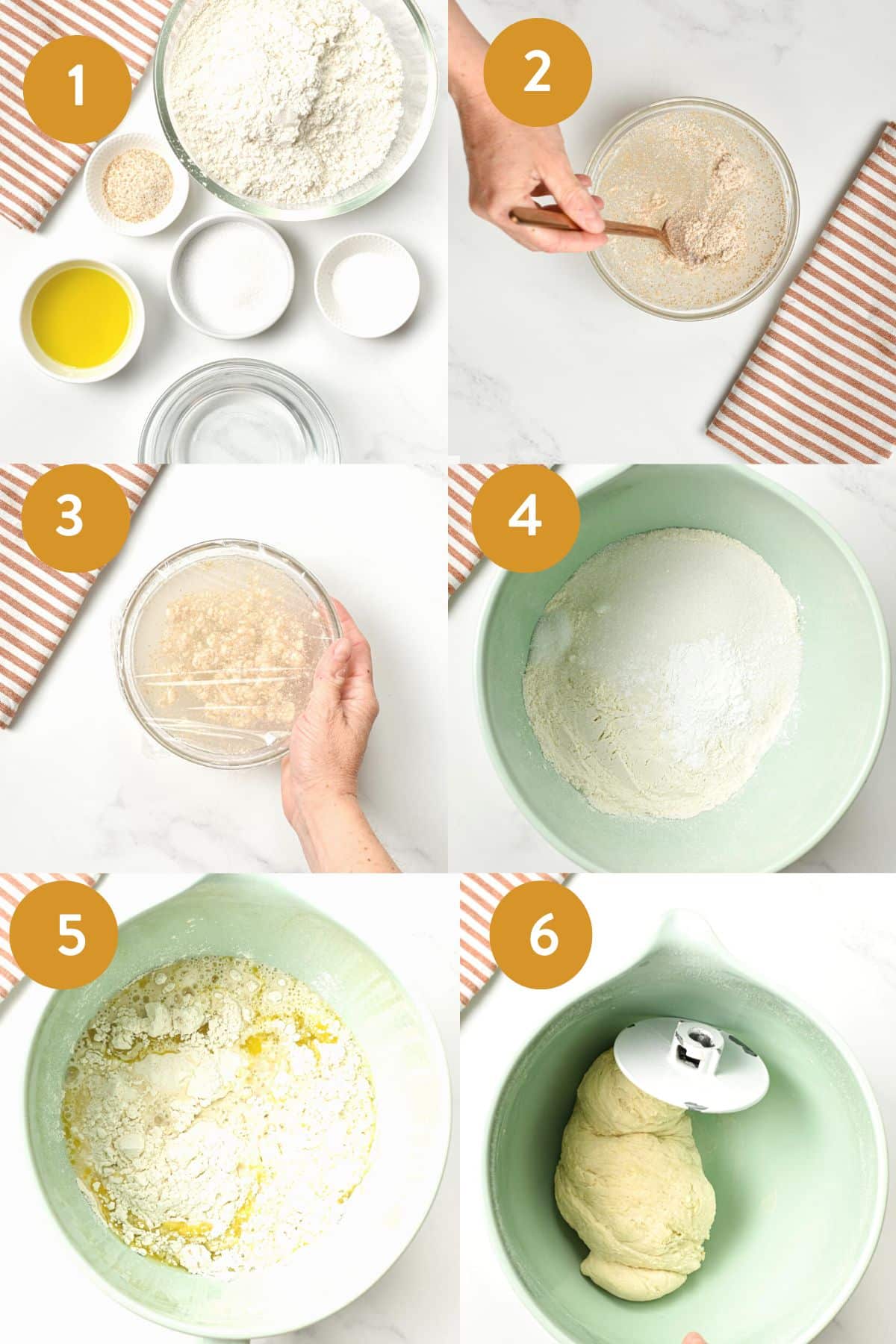
- Prepare a baking sheet covered with parchment paper. Use olive oil to lightly oil the paper. Set it aside.
- Divide the dough into two even balls. Place each dough ball on the prepared pan, leaving about a hand of space between each, so they don’t touch as they grow.
- Slightly dust semolina flour on top of the balls and gently press with floured hands to stick semolina to the dough. If you have some semolina flour, skip this step and simply sprinkle a little flour on top of each dough ball.
- Cover the tray with plastic wrap. I like to seal the tray so no air comes in. Cover the tray with a towel. I microwave my towel for 40 seconds to make it warm.
- This helps the dough rise faster. You can also pop the tray in an oven preheated to 105°F (40°C).
- Let the dough rest for 15 to 20 minutes. It won’t rise much, but the dough gets softer.
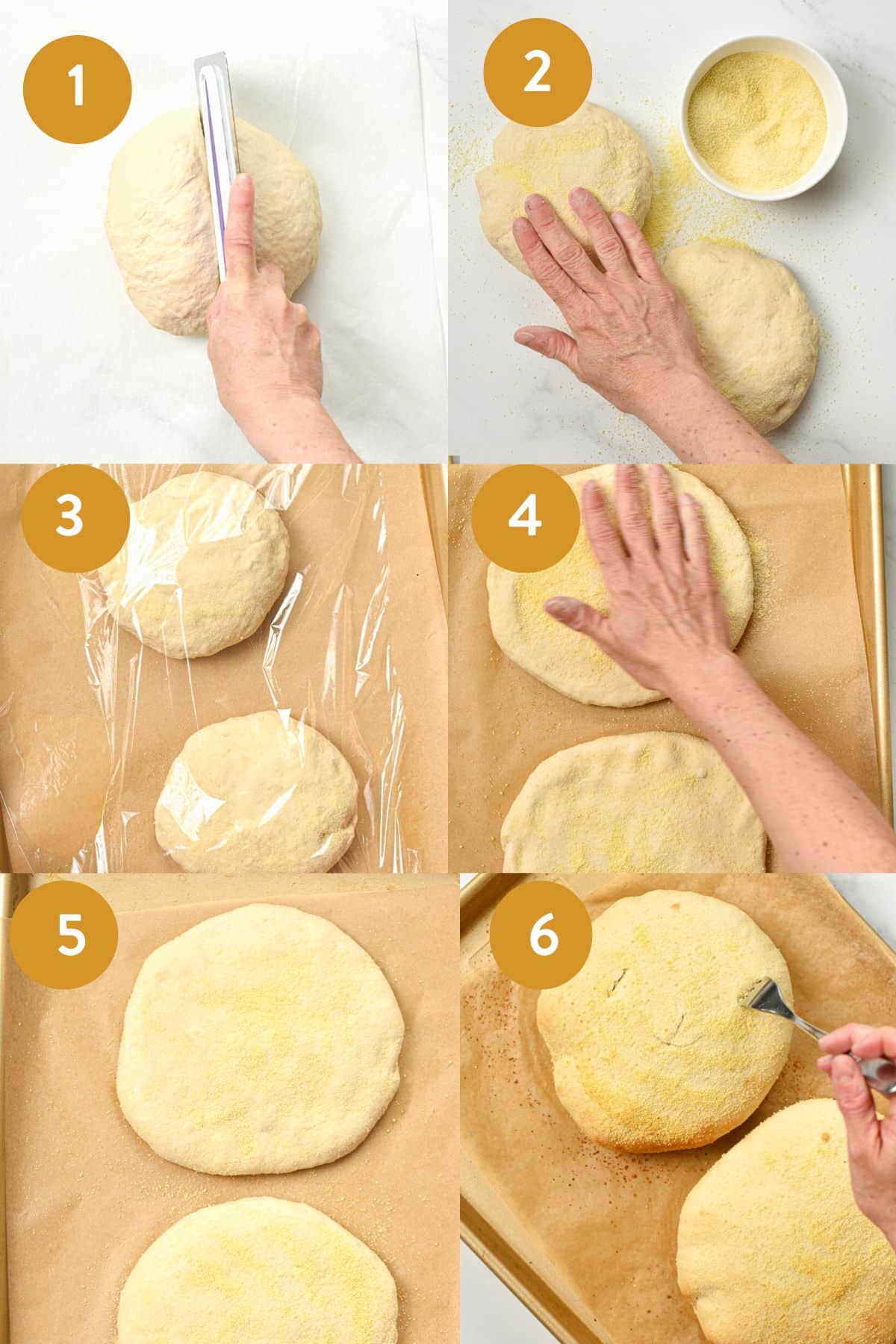
- Place one of the dough balls on a floured benchtop and use a rolling pin to roll it into a 1/4-inch flat shape.
- Sprinkle more semolina flour on both sides of the bread and press it gently to make it stick to it.
- Return the rolled bread to the previous baking sheet and repeat the above steps for the next dough ball. You now have two round bread rolls on the baking sheet. Cover the sheet with a warm, clean kitchen towel and set it aside for 60 minutes.
- Another option, if it’s too cold where you live, is to preheat the oven to 105°F (40°C), and place the tray still with a towel on top in the oven.
- Preheat the oven to 425°F (225°C).
- Remove the towel from the top of the baking sheet and prick the bread with a fork.
- Bake the bread rolls on the center rack of the oven for 15 to 20 minutes or until they are crispy and golden brown on top. It should sound hollow in the middle when you tap the bread.
- Let the rolls cool down on a wire rack before serving.
Serving
This Moroccan bread is delicious with any Mediterranean dish. Below are some serving suggestions:
Storage Instructions
Store the bread rolls wrapped in a clean kitchen towel at room temperature for up to 2 to 3 days. After that time, the bread hardens. You can also freeze leftover Moroccan bread in zip-lock bags and thaw it at room temperature the day before.

Allergy Swaps
If you are allergic to some of the ingredients in this Moroccan Bread recipe, you can try some of the following substitutions.
- Gluten-Free – We didn’t try this recipe with gluten-free flour, and we can’t guarantee the same results using an all-purpose gluten-free flour blend, but it might work.
- Sodium-Free – You can skip the salt in the recipe if needed.
- Oil Choice – You can also use avocado oil, melted coconut oil, or any oil you prefer.
- Sugar – Sugar only activates the yeast. It doesn’t leave any sugar in the recipe at the end.
Frequently Asked Questions
Yes, you can! Feel free to add some dry spices to the dough, like 1/2 teaspoon of cumin, sumac, or garlic powder.
Yes, you can shape the bread in smaller round rolls. To make pita with this dough, preheat a pizza stone in the oven for 30 minutes, then add the bread and bake for 5 to 8 minutes until they puff but don’t let the top harden.
Yes, you can cook these bread rolls like Batbout, in a non-stick cast iron pan on high heat. Cook it for 2 to 3 minutes on each side until hollow in the center.
More Mediterranean Recipes
If you like Mediterranean diet recipes, you’ll love these:
Did You Like This Recipe?
Leave a comment below or head to our Facebook page for tips, our Instagram page for inspiration, our Pinterest for saving recipes, and Flipboard to get all the new ones!

Moroccan Bread (Khobz)
Ingredients
- 3 ½ cups All-Purpose Flour note 1
- 1 cup Lukewarm Water (105°F/40°C)
- 2 ¼ teaspoons Active Dried Yeast
- 1 tablespoon Sugar
- 2 tablespoons Extra Virgin Olive Oil
- 1 teaspoon Salt
For Rolling
- ¼ cup Semolina Flour
Instructions
- In a small bowl, whisk warm water, yeast, and sugar. Cover and allow to rest for 5 minutes for the yeast to bloom.
- Pour the activated yeast into the bowl of a stand mixer – or any large mixing bowl – add olive oil, salt, and flour.
- Using the dough hook attachment or a wooden spoon, beat for 2 minutes on low speed. If too dry, add a splash of water to bring the ingredients into a dough that unsticks from the bottom of the bowl. You shouldn't need more than 1-2 tablespoons extra water if the ingredients are measured well.
- Slightly flour a work surface with flour and semolina, place the dough on the surface, and knead with lighted floured hands for 5 minutes.
- After that time, the dough should be soft, and if you press a finger onto it, the dough bounces back. It means it's ready to rise.
- Divide the dough into two even balls.
- Line a large baking sheet with parchment paper and lightly grease it with olive oil.
- Place each dough ball on the tray with about a hand of space between each so they don't touch each other as they rise. Slightly dust some semolina flour on top of the balls and press gently to stick the semolina to the dough. If you don't have semolina flour, sprinkle flour on top of each dough ball.
- Cover the tray with plastic wrap and seal it airtight. Next, add a warm, clean kitchen towel on top to add extra warmth. I like to microwave the towel for 40 seconds so it's hot and helps the dough relax and rise.
- Let dough rest for 15-20 minutes, so it rises slightly.
- Flatten each dough ball into 1/4-inch round bread rolls with floured hand or using a rolling pin on a floured surface. Press some more semolina flour on both sides if you like.
- Bring back to the baking sheet, cover the tray with the towel, and let it rise for 60 minutes.
- Preheat the oven to 435°F (225°F).
- Prick the bread rolls with a fork in a few places on the top of the bread.
- Bake on the center rack for 15-20 minutes or until the bread is golden brown and sounds hollow when tapped.
Notes
Want My Kitchen Equipment?
Nutrition
Disclaimer
The recipes, instructions, and articles on this website should not be taken or used as medical advice. The nutritional data provided on Sweetashoney is to be used as indicative only. The nutrition data is calculated using WP Recipe Maker. Net Carbs is calculated by removing the fiber and some sweeteners from the total Carbohydrates.
You should always calculate the nutritional data yourself instead of relying on Sweetashoney's data. Sweetashoney and its recipes and articles are not intended to cure, prevent, diagnose, or treat any disease. Sweetashoney cannot be liable for adverse reactions or any other outcome resulting from the use of recipes or advice found on the Website.



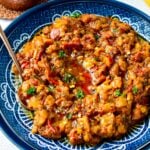


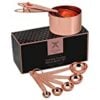

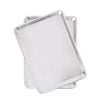
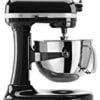

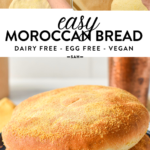

Share this post!
If you enjoyed this post, share it with your close ones!
Leave a comment
Made this bread twice so far and both times it came out great. Tastes just like the bread we had in Morocco and much better than other Moroccan bread recipes I tried. It will be my go to recipe. Thanks.
Thank you!!